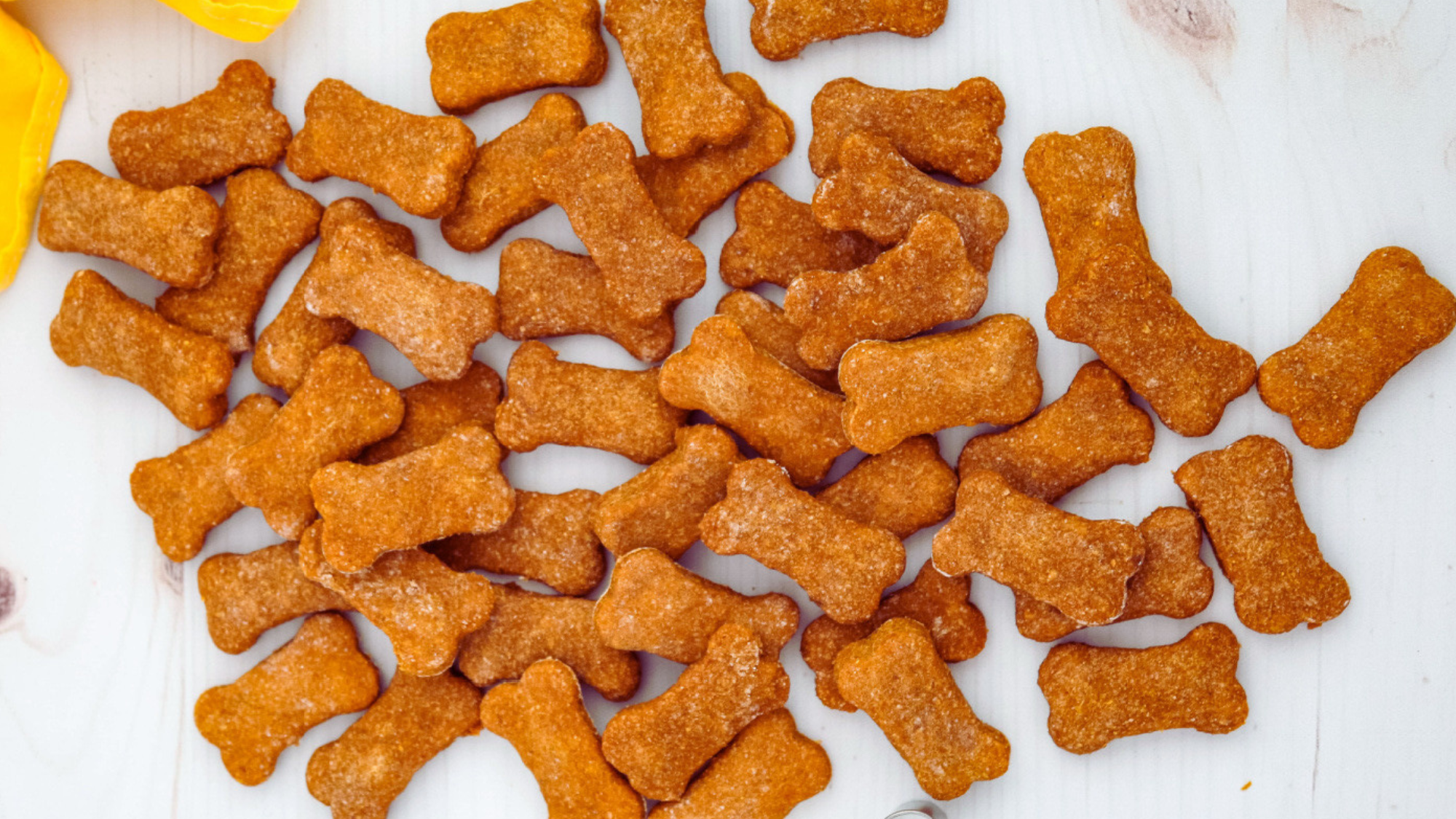| Summary: Dog treats and chews should complement a balanced diet, making up no more than 10% of daily calories. Choose high-protein, low-fat options with minimal additives. Consider dental chews for oral health and size-appropriate treats to prevent choking. Always supervise chewing and adjust portions based on your dog’s weight and activity level. |
Dog treats and chews play a vital role in training, dental health, and rewarding good behavior. While both serve as tasty incentives, they differ in texture, nutritional composition, and purpose. Treats are often used as quick rewards and can vary from soft biscuits to crunchy snacks, whereas chews are designed to satisfy a dog’s natural urge to gnaw while supporting dental health. Choosing the right dog treats ensures they are nutritious, safe, and beneficial for dental health. GPS dog collars can help track your dog’s activity to balance treat intake.
I will break down the nutritional aspects of both, explain how to incorporate them safely into your dog’s diet, and provide recommendations on how much to offer so that treats remain a healthy part of your dog’s daily intake. Some chews promote oral hygiene by reducing plaque buildup, making them great for dental care. Pet tech products like smart dispensers can regulate treat portions.
Learn more about the unique double-layered coat of an Anatolian Shepherd and how to care for it effectively.
Blog Highlights
ToggleDog Treats and Chews: Quick Comparison Table
| Factor | Dog Treats | Dog Chews |
| Nutritional Composition | Often formulated with high-quality proteins, vitamins, and minerals; available in low-calorie and high-calorie options | Rich in protein and sometimes fortified with joint-support nutrients; may include natural ingredients for dental benefits |
| Texture & Format | Soft, crunchy, or biscuit-like; designed for short-term reward | Hard, long-lasting, or pliable; designed to satisfy chewing instincts and promote dental health |
| Purpose | Used as training rewards and occasional snacks | Provides mental stimulation, aids in reducing plaque and tartar, and satisfies chewing urges |
| Feeding Frequency & Portion | Best given in small amounts (generally 10% or less of daily calories) | Typically offered as a single daily chew or as directed; portion size varies by product and dog size |
| Caloric Density | Varies widely; must be factored into daily caloric intake | Usually more calorie-dense; often recommended for limited durations to prevent overfeeding |
1. Introduction: The Role of Treats and Chews in Dog Nutrition
Treats and chews are more than just extra snacks—they serve multiple roles in a dog’s life. From training rewards that reinforce good behavior to dental aids that help maintain oral hygiene, these products offer both nutritional and functional benefits. However, it’s essential to use them wisely. Overindulgence can lead to weight gain or upset digestion, while the wrong type may lack the nutrients needed for a balanced diet.

Understanding the differences between treats and chews, as well as how they fit into your dog’s overall nutrition plan, ensures that you’re offering a balanced diet that supports long-term health and vitality. Not all chews are suitable for every dog—choose options based on size, chewing strength, and dietary needs. Electronic dog collars can reinforce positive chewing habits.
2. Nutritional Composition: What’s Inside Dog Treats and Chews
Dog Treats: Quick Energy and Flavorful Rewards
Dog treats come in a variety of forms—from crunchy biscuits to soft training treats. Their nutritional makeup is carefully balanced to provide a burst of energy without overwhelming your dog’s diet.

- Proteins: Many dog treats are made with high-quality animal proteins such as chicken, beef, or fish. Protein is crucial for muscle maintenance and repair.
- Vitamins and Minerals: Treats can be fortified with essential vitamins (like vitamin A, D, and E) and minerals that support overall health, immune function, and skin/coat condition.
- Low-Carbohydrate Options: Some treats are designed to be low in carbohydrates, which is particularly beneficial for dogs prone to weight gain or diabetes.
- Caloric Content: Quality treats typically provide a concentrated source of calories; it’s important to check packaging for calorie counts (often ranging from 5 to 20 calories per piece).
Dog Chews: Sustained Nutrition and Dental Benefits
Dog chews are formulated to satisfy the natural urge to chew and often have a different nutritional focus compared to treats.

- Protein-Rich Formulas: Many chews include concentrated protein sources to support muscle maintenance. They can be made from natural meats or protein-rich plant ingredients.
- Added Joint Support: Some chews are enhanced with nutrients like glucosamine and chondroitin, which help support joint health, especially in larger or older dogs.
- Dental Health Components: Chews often incorporate ingredients such as enzymes or abrasive textures that help reduce plaque and tartar build-up while satisfying chewing instincts.
- Caloric Density: Dog chews are typically more calorie-dense than treats. Because of their longer-lasting nature, it’s important to factor in their calorie contribution to your dog’s daily diet.
For insights on whether Pomeranians should wear a collar, including considerations for safety and alternatives, check out this informative article.
3. Digestibility, Texture, and Benefits: More Than Just a Snack
Treats: Easy to Eat and Quick to Reward
Dog treats are designed for immediate gratification. Their variety in texture—from soft and chewy to crunchy biscuits—caters to different preferences and dietary needs.
- Ease of Consumption: Soft treats are ideal for training, as they can be quickly consumed during work sessions.
- Variety for Picky Eaters: With many flavors and textures available, treats can entice even the pickiest eaters.
- Immediate Reward: Quick-dissolving treats help reinforce positive behavior during training sessions without interrupting the flow.
Chews: Durable and Dental-Friendly
Dog chews are crafted to be long-lasting, providing both a physical and mental challenge. Their design offers benefits that extend beyond simple snacking.
- Texture for Dental Health: The harder texture of many chews naturally scrapes plaque off teeth, contributing to improved oral hygiene.
- Extended Chewing Time: Chews engage dogs for longer periods, which can help reduce anxiety and provide mental stimulation.
- Variety of Materials: Chews come in different forms—some are edible, while others are non-edible (like rawhide alternatives) designed solely for dental cleaning.
4. Feeding Frequency and Portion Sizes: How Much Is Too Much?
General Guidelines for Treats
Treats should be viewed as a supplement to your dog’s primary diet—not a meal replacement.
- Daily Caloric Limit: A common recommendation is that treats should not exceed 10% of your dog’s total daily caloric intake. For example, if your dog requires 500 calories a day, no more than 50 calories should come from treats.
- Training Sessions: For frequent training sessions, opt for small, low-calorie treats that can be consumed quickly. A small pea-sized piece is often enough to reward good behavior.
- Portion Control: Use a measuring cup or scale to ensure consistency, especially if you’re switching between different treat types.
Recommendations for Chews
Chews, due to their longer-lasting nature, should be given in moderation.
- Single Daily Chew: Many manufacturers recommend offering one chew per day, adjusted to your dog’s size and caloric needs.
- Monitor Chewing Duration: While chews can provide extended enjoyment, supervise your dog to ensure they do not overindulge, which might lead to excessive calorie intake or digestive upset.
- Quality Over Quantity: Focus on the quality of the chew. Chews that are nutrient-rich and designed for dental health can be given more confidently, but always adhere to recommended serving sizes.
5. Caloric Density and Energy Balance: Keeping Your Dog Fit

Understanding Caloric Density in Treats
Dog treats vary widely in calorie content. Always check the packaging for nutritional information and serving size.
- Low-Calorie Options: Many training treats are designed to be low in calories—often between 5 and 10 calories per piece—to allow for frequent rewards without contributing significantly to daily calorie intake.
- High-Calorie Treats: Some premium or specialty treats might contain 15 to 20 calories per piece. These are best used sparingly, perhaps during special training sessions or as occasional rewards.
Managing Energy Balance with Chews
Since chews are often more calorie-dense and intended for longer consumption periods:
- Factor in Chew Calories: Ensure that any chew given is included in your dog’s total daily caloric calculation. This is especially important for less active dogs.
- Active vs. Sedentary Dogs: Active dogs may safely consume slightly more treats and chews due to higher energy expenditures, while less active dogs require stricter portion control.
- Regular Exercise: Balance treat and chew intake with regular exercise to maintain a healthy weight and overall fitness.
For a comprehensive guide on what kind of harness is best for a Pomeranian, including comfort and safety tips, check out this article. Training treats should be small, low-calorie, and rewarding without causing weight gain. Dog training equipment can help structure treat-based training sessions.
6. Specialized Nutrients in Dog Treats and Chews
Nutritional Enhancements in Treats
Modern dog treats are often fortified with additional nutrients to provide more than just a tasty snack.
- Vitamins and Minerals: Look for treats that include added vitamins (such as vitamin E for skin and coat health) and minerals (like zinc for immune support).
- Functional Ingredients: Some treats are designed with functional benefits, such as probiotics for digestive health or omega fatty acids for a shiny coat.
- Grain-Free Options: For dogs with sensitivities, grain-free treats are available that use alternative carbohydrate sources like sweet potatoes.
Added Benefits in Chews
Chews are not only about satisfying a chewing instinct—they’re also about promoting specific health benefits.

- Joint Support: Certain chews are enhanced with glucosamine and chondroitin to help support joint health, particularly in larger breeds or older dogs.
- Dental Health: Ingredients like parsley or specially designed textures help reduce plaque, contributing to healthier gums and teeth.
- Digestive Enzymes: Some chews incorporate enzymes to aid in digestion, ensuring that even though they are calorie-dense, they are easy on the stomach.
7. Cost Considerations: Balancing Quality and Budget
Investing in Quality Treats
High-quality dog treats often come with a higher price tag, but the nutritional benefits can justify the cost.
- Premium Ingredients: Treats made with natural, whole-food ingredients may be more expensive, yet they offer better nutrition and fewer additives.
- Smaller, Frequent Portions: Because treats are given in small amounts, a high-quality product may last longer and provide more health benefits per calorie.
- Long-Term Savings: Investing in nutritious treats can lead to fewer health issues over time, reducing veterinary costs.
Economical Chew Options
Dog chews can also vary in price. It’s important to find a balance between quality and affordability.
- Bulk Buying: Purchasing chews in bulk can often reduce the per-unit cost.
- Quality Over Quantity: Chews that are designed for durability and nutritional benefits may cost more upfront but are often more cost-effective over time.
- Comparing Products: Look for reviews and nutritional labels to ensure that even budget-friendly options meet your dog’s needs.
Discover if the American Eskimo is a guard dog and learn about its suitability for protecting your home.
8. Practical Feeding Guidelines and Daily Tips
Creating a Balanced Treat Routine
Establish a daily routine that integrates treats and chews without compromising your dog’s overall diet.
- Set Treat Limits: Determine the maximum number of calories or pieces per day that can be given as treats. A good rule of thumb is keeping treats to no more than 10% of daily caloric intake.
- Use Treats for Training: Reserve small, low-calorie treats specifically for training sessions to reinforce positive behavior without overfeeding.
- Alternate Treat Types: Rotate between different types of treats (e.g., soft training treats, crunchy biscuits) to keep your dog interested and to provide a range of textures and nutritional benefits.
- Monitor Overall Diet: Adjust the portions of your dog’s main meals if you’re incorporating a significant amount of treats or chews to maintain balanced nutrition.
Tips for Using Chews Effectively
- Single Daily Chew: Offer one appropriate chew per day based on your dog’s size and caloric needs. This helps prevent overconsumption while still providing the benefits of prolonged chewing.
- Supervised Chewing: Always supervise your dog with chews, especially if they are new to a particular product, to ensure safe consumption and to prevent choking.
- Hygiene and Dental Health: Use chews as a supplement to regular dental care. While many chews help reduce plaque buildup, regular brushing and professional dental check-ups are essential.
9. The Long-Term Impact of Proper Treat Management
Health Benefits of Controlled Treat Intake
Using dog treats wisely can lead to several long-term benefits:
- Weight Management: Keeping treat calories within 10% of daily intake helps maintain a healthy weight and reduces the risk of obesity.
- Improved Training Outcomes: Consistent use of low-calorie treats can enhance training effectiveness without disrupting your dog’s overall diet.
- Enhanced Nutritional Profile: High-quality treats and chews add essential nutrients and functional benefits that support your dog’s long-term health.
Potential Risks of Overindulgence
Overuse of treats and chews can lead to unwanted health issues:
- Weight Gain: Excess calories from treats can contribute to obesity, which increases the risk of diabetes, joint problems, and cardiovascular issues.
- Digestive Upset: Too many treats, especially those high in fat or artificial additives, can upset your dog’s digestive system.
- Dental Issues: While many chews improve dental health, overly hard chews or too frequent treats can sometimes cause dental wear if not balanced with proper care.
Learn about the size collar for an American Eskimo to ensure a perfect fit and comfort for your dog.
Final Verdict: Enjoy Treats and Chews in Moderation
Dog treats and chews are a valuable part of pet care, offering rewards, training aids, and health benefits. However, balance is crucial:
- Choose Wisely: Select high-quality products with natural ingredients and functional benefits.
- Monitor Portions: Keep treat calories to no more than 10% of your dog’s daily intake and adjust main meals accordingly.
- Use Chews Strategically: Offer one appropriate chew per day, and supervise your dog to ensure safe and effective use.
By following these guidelines, you can enrich your dog’s diet with tasty treats and beneficial chews without compromising their overall nutrition and health.
Discover why Afghan Hound collars are wide by exploring the unique characteristics of this breed and how wide collars enhance their comfort and style.





